This is part of a roundtable on the work of Octavia Butler. The index to the roundtable is here.
__________
The MacArthur Foundation concisely explained Octavia Butler’s impact on science fiction in 1995. Popularly referred to as “Genius Grants,” the program “awards unrestricted fellowships to talented individuals who have shown extraordinary originality and dedication in their creative pursuits and a marked capacity for self-direction.” In describing Butler, the foundation said simply, “Octavia Butler, a writer of science fiction, brought elements of African and African-American spiritualism, mysticism, and mythology to her novels and stories.”[1] The direct and simple description is both accurate and jarring. Butler’s identity as a woman of color in a genre long dominated by white men made her a unique figure, but more importantly her identity informed her work. Talented by any measure Butler’s career placed her at the center of ongoing debates about the U.S. experience linked to questions of identity and power.
To think about Butler’s contribution and status, I complied a list of scholarly articles based on search queries on Butler. From that body of material I utilized Paper Machine, a plug-in for Zotero, the bibliographic and research software created by the Roy Rosenzweig Center for History and New Media to get a snapshot of how researchers approach Butler.[2] This approach does not take the place of the critical assessments of Butler work that we have seen in the roundtable. There are limitations to this approach based on the tool and my use of it. A more compelling analysis would be gained by exploring patterns in Butler’s published works or perhaps an examination of African-American authors writing speculative fiction in the twentieth century.
What Paper Machine facilitates for me is to understand how a select body of material shifts over time and visualize those changes quickly. I added about 340 articles to my Zotero library from academic databases using Butler and related search terms. Most people who know what they are doing will point out that I need a bigger corpus. My goal is more exploratory (weak defense) and frankly I had time constraints (weaker defense). Using Paper Machine, I was able to take this collective material to create several visualizations. The first figure is a DBpedia visualization of the corpus. DBpedia is a crowd-sourced effort to create systematized information from Wikipedia and make it available on the web. Paper Machine uses the name entities mentioned in the corpus and scaled those entries according to the frequency of their occurrence to create this visualization. Naturally, the author’s name is featured prominently along with terms such as parasitism, race, and utopia.
Figure 1: Butler Scholar DBpedia
Perhaps more interestingly, Paper Machine can pull text from PDFs and use bibliographic metadata to create visualizations. This allows the program to create topic models via text mining. Paper Machine finds and clusters the words in the corpus based on the pattern of occurrence. The result is a steam graph of topics determined by the corpus. I sorted the output by the 20 “most coherent ” and “most common” topics. While Butler is the author of several noteworthy works, this modeling demonstrates that research has greater focus on Kindred (1979)and ideas such as reproduction and slavery.
Figure 2: Butler Scholar 20 Topic Most Coherent
Figure 3: Butler Scholar 20 Topic Most Common
In addition to topic models, Paper Machine can generate a phrase net that gives a sense of the order within the entire corpus. The images below are phase nets for ‘x of the y’ and ‘x and y’ in the corpus. The direction of the arrow tells us how to read the connection, and the thickness indicates the relative frequency of the phase within the corpus.
Figure 4: Butler Scholar-Phase Net x of the y
Figure 5: Butler Scholar-Phase Net x and y
&nsp;
The trends within the corpus display a pattern of analysis that parallels the topic. Phrases such as anxieties of the society or slavery and reproduction are to be expected in the corpus based on Butler’s work. Ultimately, this exercise in visualization highlights Butler’s status has grown over time as scholars discuss Butler work with greater emphasis on race, gender, and society.
This result is no surprise. As a historian, my fascination with Butler has always been rooted in this collective recognition of her as signifier. As the corpus indicates, she is often mentioned, along with Samuel R. Delany as an African-American literary pioneer. The historical reality is more complex. Authors of African descent have imagined circumstances that challenged the reality of the dominant culture for decades. Martin Robinson Delany (1812-1885), abolitionist and the first African-American field officer in the U.S. Army wrote the serial adventure of Henry Blake, an escaped slave who travels throughout the southern United States and Cuba to plan a large slave insurrection. Published in the Anglo-African Magazine in 1859 and the Weekly Anglo-African in 1861-62, the story was a response to the 1850 Fugitive Slave Act and the U.S. Supreme Court’s Dred Scott v. Sanford decision. Delany’s story offered a militant protagonist that challenged southern and northern expectations.[3] In a similar vein, Edward A. Johnson’s utopian novel Light Ahead for the Negro (1904) imagined a protagonist transported to a future socialist United States free from racial strife.[4] Surprisingly, W.E.B. Dubois’ 1920 short story, “The Comet,” featured a black bank messenger and the white daughter of a wealthy businessman as the only survivors in a city ravaged by the toxic effects of a passing comet.[5]
Science-fictional approaches to race continued into the mid-century. As society became more mediated, science fiction was an integral part of speculating on the implication of a rapidly changing world.[6] For creators committed to challenging stereotypes, memorable efforts on television such as Twilight Zone (1959-1964) and Star Trek (1966-1969) reflected the broader societal dialogue connected to racial equality. Imaginative and provocative, what these stories share is the author’s use of speculative fiction to explore their world and challenge limiting expectations. Each narrative is reacting to contemporary debates and offering ideas and actions that point to new social and political circumstances.
First published in 1971, Butler emerged as the United States struggled to reconcile the promise of the postwar liberalism with reality of a functional society that balances individual agency against communal upset. As historian Bruce Schulman explained, “In race relations, religion, family life, politics, and popular culture, the 1970s marked the most significant watershed of modern U.S. History, the beginning of our own time.”[7] An African-American female in a field associated with white men, Butler’s emergence gave voice to the challenging intersectionality linked to race and gender. For all the possibilities associated with science fiction, Butler’s work and our collective recognition of it emphasizes this struggle is ongoing and unresolved. Butler recognized the clash between ideas and actions and made her writing about, “… when you are aware of what it means to be an adult and what choices you have to make, the fact that maybe you’re afraid, but you still have to act.”[8] Working through the lens of her identity within two marginalized groups, her vision has grown in importance as the wider society moves these questions to the center of our public discourse. No longer in an era of pioneering firsts, debates about equity and representation in science fiction have grown in importance as imagined and real landscapes converge. It is too much to suggest understanding Butler means unraveling this problem, but her advice to aspiring writers highlights why the effort bears worthwhile fruit–“I’ve talked to high school kids who are thinking about trying to become a writer and asking ‘What should I major in?’, and I tell them, ‘History. Anthropology. Something where you get to know the human species a little better, as opposed to something where you learn to arrange words.”[9]
__________________
[1] “Octavia Butler,” www.macfound.org, (July 1, 1995), http://www.macfound.org/fellows/505/.
[2] “Zotero | About,” www.zotero.org, accessed July 5, 2014, https://www.zotero.org/about/.
[3] Katy L. Chiles, “Blake; or the Huts of America (1859–1861),” Encyclopedia of Virginia, (September 24, 2012), http://www.encyclopediavirginia.org/Blake_or_the_Huts_of_America_1859-1861.
[4] Maryemma Graham, The Cambridge Companion to the African American Novel (Cambridge University Press, 2004), 42–43.
[5] W.E.B. Dubois, “Darkwater: Voice From Within The Veil,” Archive, www.gutenberg.org, (1920), http://www.gutenberg.org/files/15210/15210-h/15210-h.htm.
[6] J. P. Telotte, The Essential Science Fiction Television Reader (Lexington: The University Press of Kentucky, 2008), 3.
[7] Bruce J Schulman, The Seventies: The Great Shift in American Culture, Society, and Politics (Cambridge, MA.: Da Capo Press, 2002), xii.
[8] “Octavia E. Butler Interview (excerpts),” Magazine, Locus Online, (June 2000), http://www.locusmag.com/2000/Issues/06/Butler.html.
[9] Ibid.

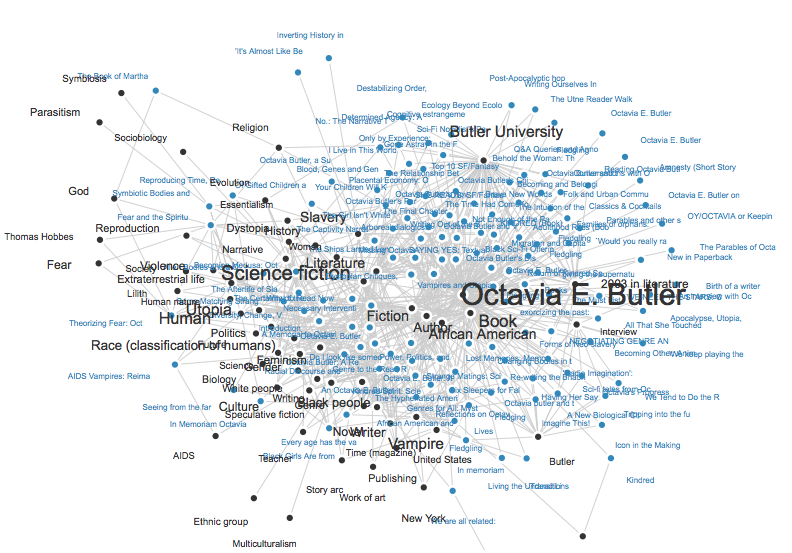
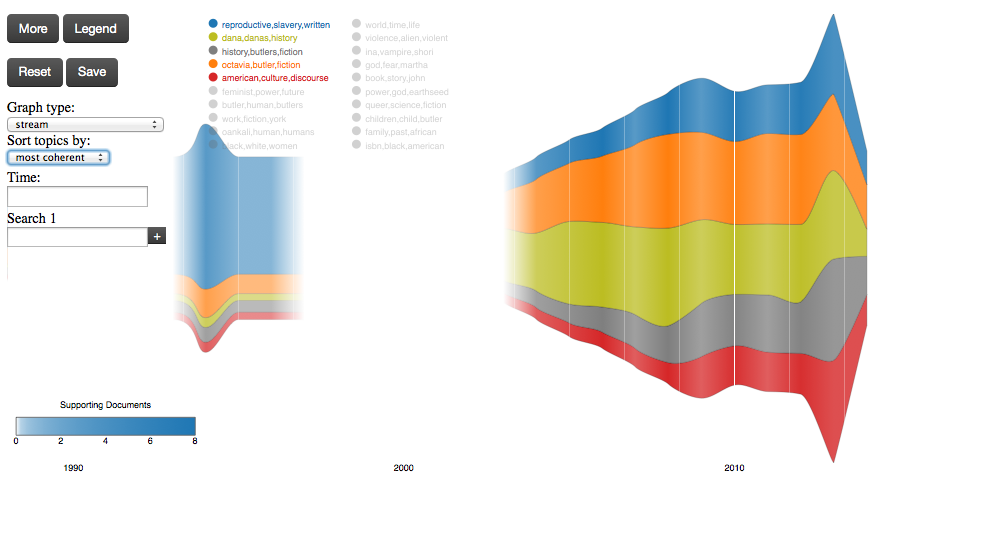
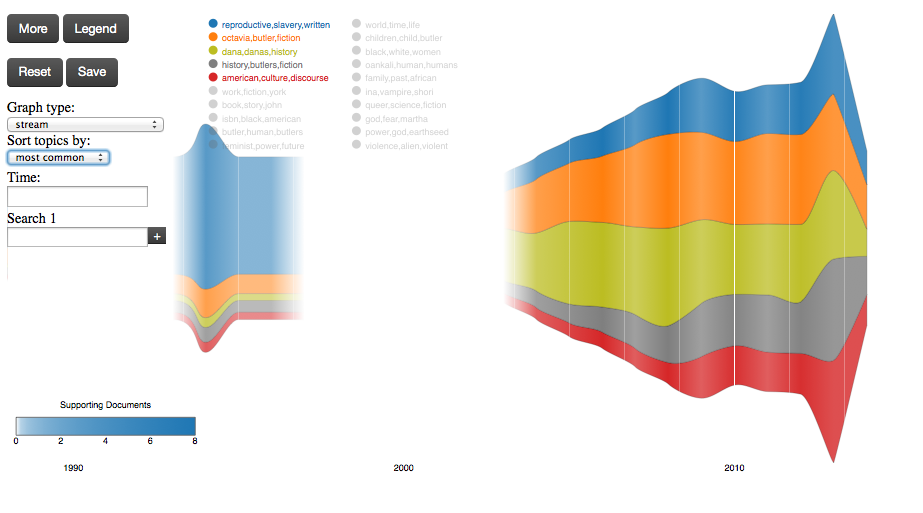
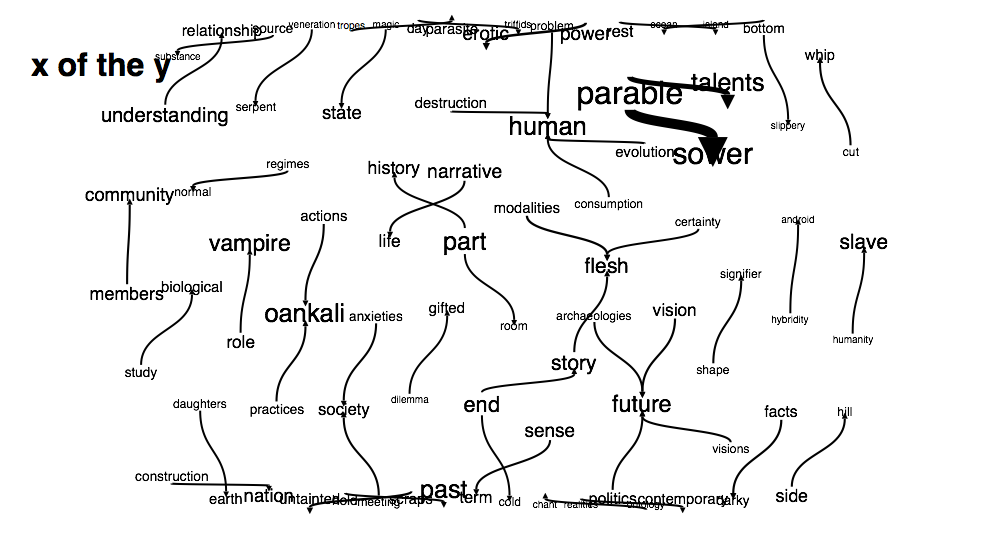
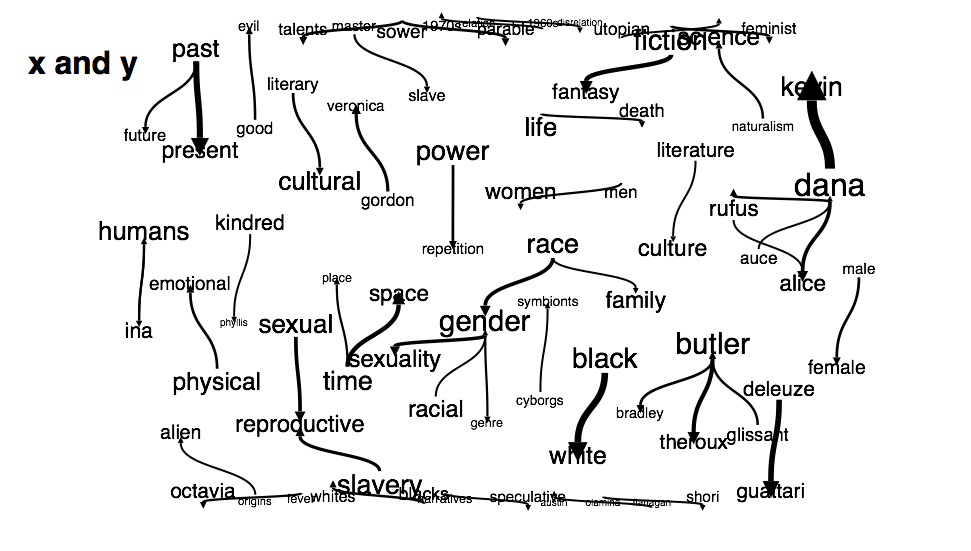
Impressive, Julian! I guess I’m not surprised to see Kindred dominating the academic interest in her work. Two questions, though: were there any topics that you were surprised to see or topics that you thought would have attracted more attention, but didn’t? Also: do you thing breaking this down by discipline would yield some interesting results too? I suspect that the Parable series might be a favorite among religious studies scholars, while the Women/Gender Studies scholars might not have Kindred at the top of their list.
In many ways this analysis is crude. Indeed, a better approach would have created a larger corpus and I would have used greater care around disciplinary language and relationships.
I don’t think any topic surpised me, but I assumed that Butler’s later work would be higher in the topic modeling. Kindred’s persistence makes sense, but I assumed later work would be central to academic studies.
I’m curious as to whether she’s generally taught in an African-American studies context or in a science-fiction genre context…the focus on Kindred suggests more the first, yes?
To answer the question about context, I think Butler is the point of intersection on diaspora studies and science fiction. Better late than never :-)